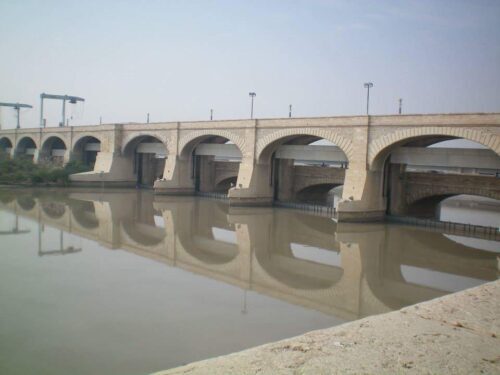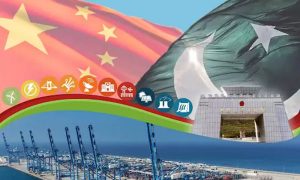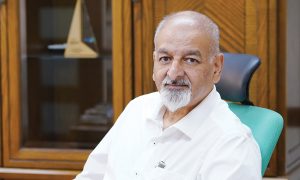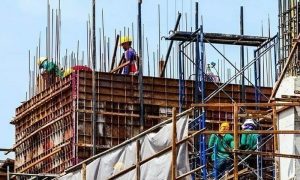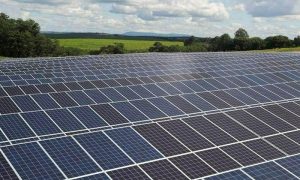Much-awaited rehabilitation of Sukkur Barrage, in principal, has agreed to finance by the world bank for which the authorities are directed to ask Sindh government to submit the PC-1.
Decision, in this regard, was made at a meeting between Sindh Chief Minister Syed Murad Ali Shah and the World Bank’s Country Director Patchamuthu Illangovan-led delegation comprising 14 experts and sector chief that was held. The chief Minister was assisted by Provincial Ministers for Home Sohail Siyal, Local Government Jam Khan Shoro, Population Welfare Mumtaz Jakhrani, Chairman P&D Mohammad Waseem, Principal Secretary to the CM Sohail Rajput, Secretary School Education Iqbal Durrani, Secretary Health Fazal Pechuho, Secretary irrigation Jam Shah, Secretary Population Laiq Ahmed and others.
Murad Shah said that consultation on the feasibility study for rehabilitation of Sukkur Barrage was conducted and the draft feasibility was reviewed by experts. The World Bank experts including experts in Dam Design, Sedimentation and Structures further revised the feasibility study.
Shah said the Consultant’s Environmental Impact Assessment (EIA) Report was also reviewed by International POE in August 2017, after public hearing for the project’s environmental impacts. The international POE has also submitted Environmental and Social Assessment Report.
The chief minister said Sukkur Barrage structure has been declared safe and rehabilitation works could extend its life, indefinitely. He said rehabilitation works for exiting barrage selected for design discharge of 1.3 million cusecs, which would not require any changes in the existing right pocket river training works. He said that additional studies have been recommended during the implementation stage. They include location study for a new barrage, Sediment Transport Modeling and Monitoring Study, Physical Model Study in UK/Holland for Consultant’s recommendation for changes in right pocket river training works, enabling increase in the Barrage flood-handling capacity to 1.5 million cusecs.
Rehabilitation works would be implemented over a period of four years.
The repair work on barrage and canal regulators structure under which RCC Arches of Barrage (200 numbers), Stone Arches of Head Regulators (165 numbers), Stone Piers (128) and Head Regulators (110), Stone Filling above Arches of Barrage and Head Regulators would be done. There would be a complete replacement of Gate Deck Flooring, replacement of Barrage Road Surface and Storm water drainage. It will also include rise in height of existing Left Pocket divide walls.
Dredging and canal de-silting would be made on the left and right pockets, approach and tail channels, approach to left pocket, channel at downstream of right pocket and de-silting of Dadu, Rice and NW Canals.
Replenishment of scour protection works foundation inspection and repairs of building works include the works of central control and monitoring office and workshops, a mosque and officer’s residence and Rest House.
Monitoring and Control Instrument would have automatic water level recorders, vibrating wire piezometers, reactivation of existing water level observation wells, Acoustic Doppler Current Profiler (ADCP) for Bathymetric Survey, Permanent Discharge Measurement Station using Horizontal Acoustic Doppler Profiler (H-ADCP and CCTV and Telecommunication.
Murad Shah said mechanical works and procurement include repair and epoxy coating in all gates, increasing gate height by 2ft, replacing existing temporary wooden planks, increasing of freeboard for full open condition by changes in gate hoisting to work without counterweights, installation of required gate lifting motors for each gate, replacing the existing system of four trolley-mounted motors for operation of all the gates, replacement of all moving components and seals, fabrication of Pontoon Mounted Caisson Gates and procurement of dredger, tug boat, motor boats and launch.
The chief minister said that as per recommendation in the feasibility report, complete replacement of all electrical works such as switchboards and local control panels with cabling, dedicated feeding from WAPDA Grid Station, 11 Kv transformer and main controls switchboard and standby generators.
The chief minister said that project would cost around Rs16.256 billion. The repair work on structure would cost around Rs 1,061.4 million, dredging and canal de-silting to cost Rs 3,708m. Replenishment of Scour Protection Works to cost Rs 571.5 million, Foundation Inspection and Repairs Rs1,967.6 million, Building Works Rs356.3 million, Monitoring and Control Instrumentation Rs238.2 million, Gates & Mechanical Works and Procurement to cost Rs3,335.5 million, Electrical Works Rs634.2 million, Project’s Insurance, Client and Engineers Facilities Rs 524.9 million, Additional Studies Rs 682 million, Project Management and Supervision Rs1,064.1 and Physical Contingencies and Price Escalation Rs 2,121.6 million.
The World Bank Country director urged the chief minister to ask his team to submit PC-1 of the project so that it could be formally approved.


